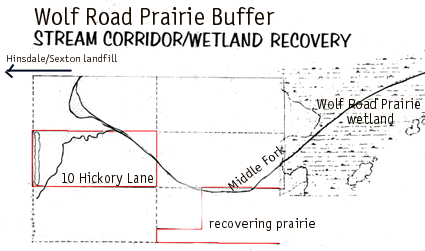NATIVE ECOSYSTEM RESTORATION
History of the Restoration Site
Role of Buffer Sites in Preserving Biodiversity
--Protecting Original
Landscapes
--Providing Habitat for
Native Species
Project Goals and Purpose
Restoration Strategy and Methods
Site Biodiversity
Education and Outreach
Project Participants
|
Role of Buffer Sites in Preserving Biodiversity Buffers protect high quality natural areas from adjacent incompatible land uses. They preserve and maximize biodiversity and insure that ecosystems function at a level that sustains species. Buffers provide a counter measure to fragmented landscapes. Changes in land use that fragment large tracts have been described by conservation biologists Wilcox and Murphy (1985) as “... the most serious threat to biological diversity and the primary cause of the present extinction crisis.” Description of Project The Wolf Road Prairie wetland is negatively impacted by discharge originating on the upstream 275 acre Hinsdale/Sexton landfill. The remediation techniques reduce streamflow velocity while increasing the quality of surface waters prior to their discharge into the Wolf Road Prairie wetland. The stream water enters the Wolf Road Prairie wetlands carrying reduced sediment and landfill contaminants resulting in water quality enhancement, increased infiltration and groundwater recharge.
The 10 Hickory Lane project protects Wolf Road Prairie by adding an additional 5 acres to the preserve as buffer. The site features stream corridor, savanna and prairie uplands. The vegetative restoration focuses upon revitalizing the natural landscape by stimulating native plant recovery. This includes managing existing native populations and re-introducing supplemental native species. |
 drawing from Save the Prairie Society archives
drawing from Save the Prairie Society archives